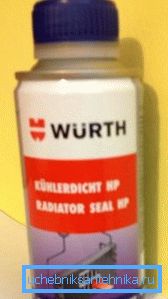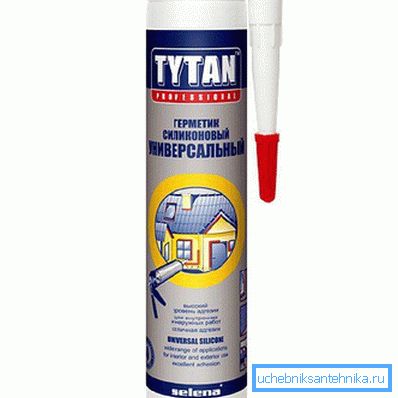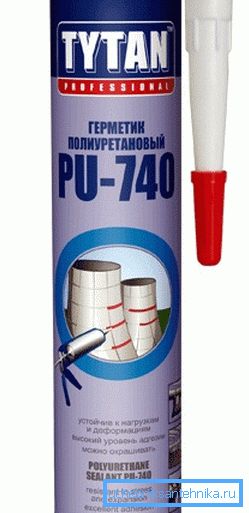Radiator sealant: types and use
Often in the repair and installation of radiators use a substance such as sealant. From the name it is easy to guess that it is intended to ensure the tightness of the connections and eliminate leakage. In this article, we look at what kind of sealant for the radiator is better and how to apply it.

Primary requirements
Sealant for heating radiators may be needed not only during the installation of the latter, but also for repairs, for example, when the batteries are disassembled into sections or leaks appear in them. The use of this substance will guarantee the tightness of all joints, which will not be destroyed even after heating.
It should be noted that currently there is a wide range of different types of sealants on the market that are designed for different purposes. Of course, this somewhat complicates the choice.
Therefore, in order not to be mistaken, first of all it is necessary to determine the basic requirements that this substance must meet.
So, given the conditions in which the sealant will be operated, it can be concluded that it must have the following qualities:
- Heat resistance;
- Resistance to deformation;
- Moisture resistance;
- Resistance to temperature extremes.
Below we consider what types of sealants meet these requirements.

Types of sealants
In terms of their composition, sealants are divided into three types:
- Acrylic - are unstable, poorly tolerate temperature extremes.
- Polyurethane - differ in elasticity, good adhesion to metal surfaces, resistance to corrosion and high temperature.
- Silicone - are the most common type of sealants, due to their versatility. Moreover, this tool retains moisture resistance and elasticity in a fairly wide range of temperature regimes.
- Liquid polymer - used in heating systems specifically to eliminate leaks. They are a liquid that polymerizes on contact with air.
Below we take a closer look at the most common types of sealants.
Universal Silicone
The most common today is a universal heat-resistant sealant, which is most often used to seal joints. This composition has all the necessary qualities.
In particular, among its properties are the following points:
- Good strength;
- The composition is quite liquid and fluid, due to which it is able to penetrate even into the narrowest slits;
- Good elasticity.
Note! For radiators, you can use only a neutral variety of silicone compounds, but not acidic, since the acid causes active corrosion of the metal.
I must say that this sealant is used not only for heating systems, but also used for other household purposes, as well as in industry.

Polyurethane
A distinctive feature of these compositions is durability and resistance to aggressive environment, as well as mechanical stress. In addition, the advantages include cost-effective composition.
It should be noted that polyurethane sealants are one- and two-component. The first freeze longer, however, their price is lower. It must be said that despite the mass of positive qualities, polyurethane compounds are less common in everyday life than silicone, as they are more expensive.

Liquid polymer
All of the above compositions are intended for external application to the radiator or treatment of threaded connections. But, in some cases, it is impossible to close the outside flow, for example, if it is difficult to detect a damaged area. Then polymer liquid sealant comes to the rescue.
The principle of its operation is based on the fact that it is poured into the system along with the coolant. At the site where there is a leak, the composition begins to interact with the air and polymerizes. Thus, the clots of the composition stick a gap.
It should be noted that there are several types of liquid sealants:
- For water systems.
- For systems operating on antifreeze.
- For sealing metal surfaces.
- For plastic pipes.
Thus, before you purchase the composition, you should read the information that contains instructions on the package.

Using
External processing
So, with the types of compositions we have reviewed, now consider how to use sealant for the radiator.
The work is done in this order:
- If it is necessary to eliminate the leak, then first of all it is necessary to find the damaged area.
- Then you need to drain the coolant from the radiator.
- Next, you need to do your own hands to clean the damaged area from dust, dirt, old paintwork, etc.
- After that, the composition is applied to the treated area.
- Then you need to wait for the sealant to dry, then you can fill the system.
Internal processing
Now consider how a polymerizable sealant is used for radiators.
This process is not much more complicated than external processing:
- Before pouring the sealant into the radiator, it is advisable to rinse it with running water.
- Next you need to dismantle all filters or cut off their cranes.
- Then you need to start the system and heat to 50-60 degrees.
- After that, it is necessary to release air from the system, otherwise it will begin to interact with the tool.
- Next, you need to drain the water from the system and use it to prepare a solution. In this case, a couple of liters should be left to flush the pump.
- Then you need to dismantle the crane Mayevsky from the battery, and instead connect the pump type "Kid".
- Using a pump, a solution of sealant with water is introduced into the system. If the volume of coolant in the system does not exceed 80 liters, one liter of product is sufficient. Otherwise, its amount should be increased.
- Next, you need to increase the pressure in the system to 1.5 atmospheres.
- The heating system must be maintained in this mode for several hours, until the product is polymerized.
- Then you need to release the coolant, fill it with water and then drain it again. However, before rinsing the radiator after the sealant, you should make sure that the leak is completely eliminated.
Note! This method of eliminating leaks can be used only for those cases where the rate of leakage of fluid from the radiator does not exceed 30 liters per day.
This completes the process of radiator cracking.
Conclusion
There are several types of sealants that can be used for radiators. In order to make the right choice, you need to decide on the tasks that the composition has to solve - this can be sealing of threaded connections or sealing of cracks. However, any sealant will be effective only if the instructions for its use are followed.
You can read some additional information on this topic from the video in this article.